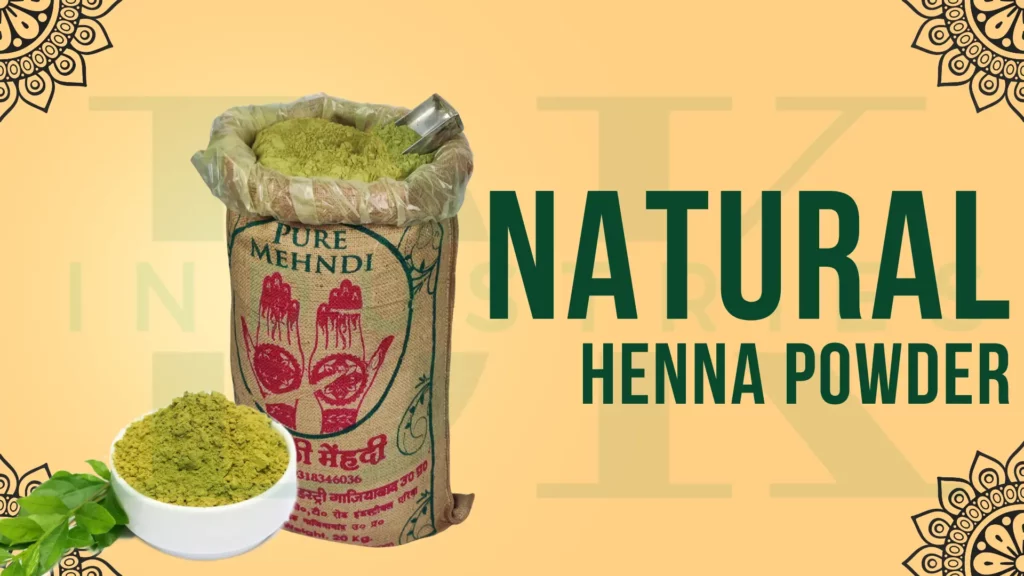Table of Contents
Henna powder has been used for thousands of years as a natural hair dye, body art, and traditional medicine. Also known as Lawsonia inermis, henna is a flowering plant that grows in hot, dry climates such as India, Pakistan, and the Middle East. The leaves of the henna plant are harvested, dried, and ground into a fine powder, which can be used to create a natural hair dye that is both safe and effective.
WHAT IS HENNA POWDER?
Henna powder is a natural dye made from the leaves of the henna plant. When mixed with water or other liquids, it releases a natural pigment called lawsone, which binds to the keratin in hair and skin, creating a reddish-brown stain. Henna powder is often used as a hair dye alternative to commercial chemical dyes, which can damage hair and scalp.
BENEFITS OF HENNA POWDER
SAFE AND NATURAL
| Henna powder is a safe and natural alternative to commercial hair dyes, which often contain harsh chemicals that can damage hair and scalp. Henna powder is also free from ammonia, peroxide, and other synthetic additives that can cause allergic reactions. |
STRENGTHENING PROPERTIES
| Henna powder has natural strengthening properties that can improve hair texture, increase volume, and reduce hair fall. Henna powder can also help to repair damaged hair and split ends. |
LONG-LASTING COLOR
| Henna powder creates a long-lasting, natural-looking color that fades gradually over time. Unlike chemical dyes, which can fade quickly and unevenly, henna powder creates a consistent color that lasts for several weeks. |
VERSATILE | Henna powder can be used to create a range of colors, from reddish-brown to dark brown or black. It can also be mixed with other natural ingredients such as indigo or cassia to create custom shades. |
HOW TO USE HENNA POWDER
Before using henna powder as a hair dye, it is important to do a patch test to check for any allergic reactions. To do a patch test, mix a small amount of henna powder with water and apply it to a small area of the skin. Wait for 24 hours and check for any redness or irritation.
To prepare henna powder for use as a hair dye, follow these steps:
• Mix henna powder with water to create a paste. The consistency should be similar to yogurt.
• Let the paste sit for a few hours to allow the pigment to release.
• Apply the paste to clean, dry hair, starting at the roots and working your way down to the ends.
• Cover your hair with a shower cap or plastic wrap and let the paste sit for 2-4 hours.
• Rinse the paste out of your hair with warm water, and then shampoo and condition it as usual.
It is important to note that henna powder can be messy and may stain clothing and surfaces. It is recommended to wear gloves and protective clothing when applying henna powder.
CONCLUSION
Henna powder is a safe, natural, and versatile hair dye alternative that has been used for thousands of years. It has natural strengthening properties and creates a long-lasting color that fades gradually over time. When using henna powder, it is important to do a patch test and follow the instructions carefully to achieve the desired results.
FAQ
Henna Powder - Your Questions Answered | D.K Industries
Henna powder is generally safe to use on all hair types. However, it is recommended to perform a patch test before applying it to your hair to check for any allergic reactions.
Henna powder cannot lighten hair. It primarily provides reddish-brown to dark brown or black shades, depending on the original hair color.
Henna powder hair color can last for several weeks. The color gradually fades over time, but the exact duration may vary depending on individual hair characteristics and aftercare practices.
Yes, henna powder can be used to cover gray hair. However, it is important to note that the color outcome may vary, and multiple applications may be required for desired coverage.
No, henna powder does not provide instant results. The color develops gradually over a few hours or days after application, and the final shade is typically achieved after 48 to 72 hours.
Henna powder can be used on chemically treated hair, but it’s recommended to perform a strand test or consult a professional hair stylist for guidance. The color outcome may be influenced by the existing treatment.
While henna powder is generally considered safe, it is advisable to consult with a healthcare professional before using any hair dye products during pregnancy.
Yes, henna powder has natural strengthening properties that can improve hair texture, increase volume, and reduce hair fall. It can also help repair damaged hair and split ends.
Henna powder is generally well-tolerated, but some individuals with sensitive scalps may experience mild irritation. It is advisable to perform a patch test before applying henna powder to the entire scalp.
Henna powder is generally safe to use on children, but it is recommended to perform a patch test and monitor any reactions. Care should be taken to avoid contact with the eyes and mouth.
Henna powder can be applied to the hair every 4-6 weeks, or as needed to maintain the desired color intensity. Frequent application does not cause damage to the hair.
Henna powder can provide a subtle reddish-brown tint on dark hair. The color outcome may not be as vibrant as on lighter hair, but it can still add richness and shine.
It is not recommended to use henna powder on synthetic or colored hair extensions, as it may cause undesirable color results or damage the extensions. Consult the manufacturer or a professional for suitable alternatives.
Henna powder can be used on eyebrows and facial hair, but caution should be exercised to avoid contact with the eyes. It is recommended to perform a patch test and follow specific instructions for facial hair application.

